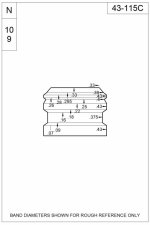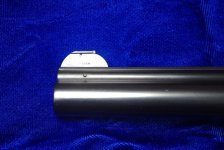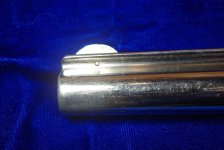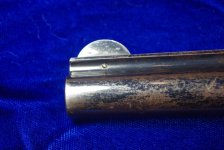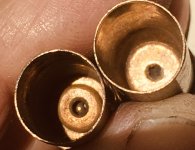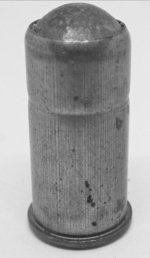I haven't located the original Black Powder target loading for the 44 Russian but if we do the simple Math? Here are the results from known Black Powder target loads:
Standard Service Load for .44 Russian, was / is 23 Grains, 3F, and, 246 Grain Bullet ( and small variations in weight of either component, also existed ).
: If we compare the 32-44 and 38-44 Target loads listed in antique Distributor catalogs? We see a heavy load of FFFG black powder with a Medium weight bullet for that caliber.
32-44 83 Grain RN Target Bullet 19 Grains FFFG
38-44 140 Grain RN Target Bullet 23 Grains FFFG
44 Russian 160-175 Grain RN Target Bullet 28-30 Grains FFFG
(*Estimated load for 44 Russian Target New Model 3)
Of course, with Black Powder Revolver, heavier Bullets have a little higher FPS than lighter ones, or maybe quite a bit more, depending...
Larger charges for lighter Bullets may be less efficient than smaller charges and Bullet seated deeper, or lighter charges and having 'filler' to allow normal compression and normal Bullet Seating for Bullets one wishes to crimp at a normal Crimp location ( Malto Meal, Corn Meal ) otherwise one is just blowing out a lot of un-burned Powder since the lighter Ball or Bullet accelerates out of the Barrel sooner, having less inertia, giving less burn time for the Powder, and not reaching as much FPS as a heavier Bullet would have.
This solution makes sense and might be surprising for some but the load is designed to be "HEAVY". The problem being that in order to achieve that load you must use a "Balloon Head" case. I have several Semi-Balloon Head cases in 44 Special. See Photo. That I plan on using for this test after trimming them down to correct length for the 44 Russian revolver chamber. See photo of original 44 Russian Winchester "TARGET BULLET" in a balloon head case. Unknown load but estimated at between 28-30 grains of FFFG "compressed". Likely a "NAIL DRIVER" at ranges up to and including 50 yards!!
*** All of these loads should be "extremely" accurate. In fact I would stand them up against "any" smokeless target load at ranges up to 50 yards for off hand pistol shooting. Perhaps beyond that range?
Murph
As far as I gather -
What we now call 'Balloon Head' are what was originally called "Solid Head".
'Folded Head' was the original Metallic Cartridge Case, and was used for all the Rim Fires, who's wall and rim and head section was about the same all over, and the original external prime Primer Pockets of the earliest external-prime Center Fire Cases, the Primer Pocket was merely made by shaping or folding in and up and over, the center of the Case Head, who's Head thickness was about the same as the Case Walls, and, of course, this was a little weak, but more so, I suspect was evolved out of for being a little tedious for the Manufacturer to shape and form, requiring more annealing pauses, and more steps and draws than the 'Solid Head'.
"Solid Head" ( which we see mentioned on 1880s, 1890s Ammunition Box Labels or in advertisements for Ammunition of that time on onward for quite a while,) was the advent of a Cartridge Case having a slightly thicker Head face area, ( less tedious to make the Primer Pocket and more material to punch or draw it in to,) with the Primer Pocket shaped or formed in a heavier section, and these when we look in to the empty Case, we see the elevated Primer Pocket, with a Moat or Trough around it.
The next step eventually was to have a very thick Head, as thick as the Primer Pocket is tall, where in looking down in to the empty Case, we see merely a slightly dished bottom, and the center flash hole.
Logically, this is what one may expect the term "Solid Head" to mean, but oddly, the "Modern" Case design does not seem to have a name.
I am not sure when the term 'Semi Balloon Head' came in, or if it is a modern term, retro-actively applied, nor how it is imagined to differ from a Balloon Head proper...unless "Balloon Head" is understood to mean the earliest Folded Head Center Fire Cases, and Semi Balloon Head taken to mean what at the time was called "Solid Head", and what generally we now call "Balloon Head" with the latter being the 'Semi Balloon Head'.
I did compare ( what we now call ) Balloon Head ( nee: 'Solid Head' ) and modern Brass some time back, for .44 Russian and others to determine difference in Case volume, and I do not know where those notes are at the moment.
If memory serve though, I think for .38 Special, the difference is about 15 percent.
Larger diameter Cases, the difference is a slightly larger percentage.
Let us bear in mind, that if appealing to 'Smokeless' Loading Tables from the earlier 1900s, or from before WWII, which were written with the original 'Solid Head' - now called 'Balloon Head' Cases as tacit / given, if one is using the usual 'Smokeless' Propellants listed in these Loading Tables, and using modern Brass, one will have a meaningfully smaller Case Volume and a very different 'Loading Density' than intended...
...which will then result in higher pressures, or even send things in to over-pressure if using higher loadings...and, I suspect this is why sometimes on Forums one sees people writing in, saying Bullseye or Unique must be stronger now than 'back when', having loaded up some Revolver Cartridges using a 1920s IDEAL Handbook or other Tables of the time, and full or max charges of Bullseye or Unique, when, it is the loading density difference of Case volume, with their smaller volume modern Brass of today, that is at issue.
Catastrophic "Over Pressure" could possibly result if using max Charges of Bullseye or Unique if substituting modern Brass for the Brass intended from the era the old Loading Table was written.
If I am remembering right, new 'STARLINE" Brass, .44 Russian, 23 Grains of BP, just about fills the Case up to the Case mouth...presenting then an awkward conflict if one were intending Standard, Black Powder Loading, of Service Rounds...as the amount of 'compression' needed for the 246 Grain Bullet to seat and crimp as expected, would be enormous or impractical to achieve with usual Loading Tools.
While, for light to medium Black Powder Loading Charges in .44 Russian Black Powder, 20 odd percent or so smaller volume modern Brass ought to work fine and allow a nice usual compression.
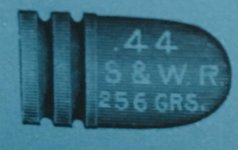 57D6FB35-6194-4AE8-B123-575EF0D9AAC0.jpg36.1 KB · Views: 53
57D6FB35-6194-4AE8-B123-575EF0D9AAC0.jpg36.1 KB · Views: 53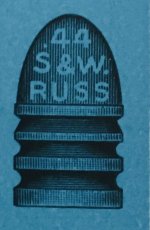 3321B585-7247-404B-AEB5-5E772B6CAA9F.jpg52.8 KB · Views: 56
3321B585-7247-404B-AEB5-5E772B6CAA9F.jpg52.8 KB · Views: 56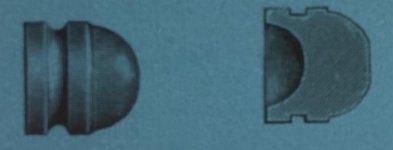 B840B23E-ED4B-422F-9A05-B6415F1D171E.jpg14.8 KB · Views: 57
B840B23E-ED4B-422F-9A05-B6415F1D171E.jpg14.8 KB · Views: 57 BA5D7486-ACFD-441A-85BF-120677A028EF.jpeg72.5 KB · Views: 76
BA5D7486-ACFD-441A-85BF-120677A028EF.jpeg72.5 KB · Views: 76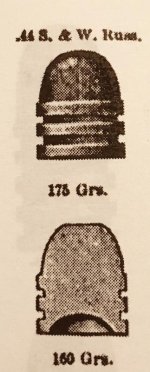 639CB7AC-3CC7-40EC-A703-9050FCBD208C.jpg43.7 KB · Views: 61
639CB7AC-3CC7-40EC-A703-9050FCBD208C.jpg43.7 KB · Views: 61




